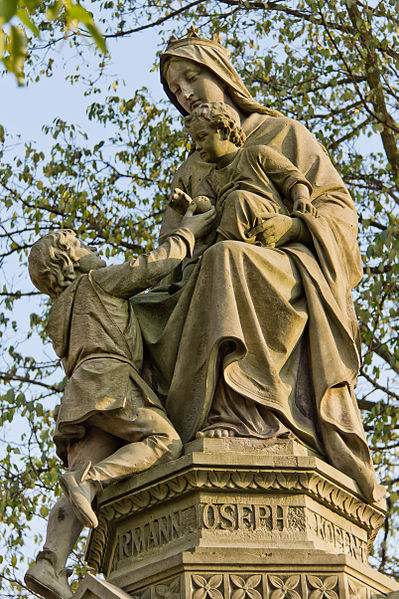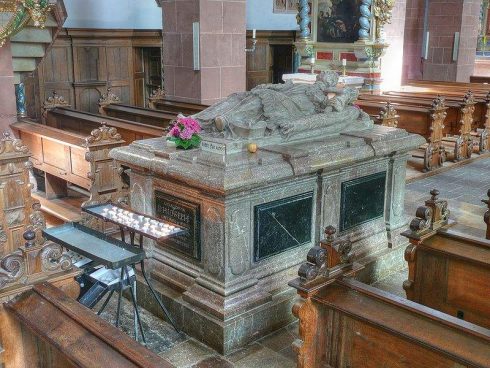Bl. Hermann Joseph
Premonstratensian monk and mystic; born at Cologne about 1150; died at Hoven, 7 April, 1241.

Statue of Bl. Hermann Joseph presenting an apple to the Infant Jesus. Statue is atop a fountain in Waidmarkt, Köln. Photo taken by © Raimond Spekking.
According to the biography by Razo Bonvisinus, contemporary prior of Steinfeld (Acta SS., 7 April, I, 679), Hermann was the son of poor parents who had once been rich. At the age of seven he attended school and very early he began the tender devotion to the Blessed Virgin for which he was known during his entire life. At every available moment he could be found at the church of St. Mary on the Capitol, where he would kneel wrapt in prayer and child-like appeal to Mary. One day he is said to have presented an apple, saved from his own scanty repast, to the Child Who accepted it. According to still another legend, on another occasion, when on a bitter cold day he made his appearance with bare feet, Mary procured him the means of getting shoes. At the age of twelve he entered the monastery of the Norbertine or Premonstratensian Canons at Steinfeld, in the present Rhenish Prussia, made his studies in the Netherlands, and on his return was entrusted with the service of the refectory and later of the sacristy.
 After he had been ordained priest, it was remarkable with what reverence and devotion he offered the Holy Sacrifice. He was known for his gentle demeanour and affability, his humility, his extraordinary mortifications, but, above all, for his affection for the Mother of God, before whose altar he remained for hours in pious intercourse and ecstatic visions, and in whose honour he composed wonderful prayers and hymns. Mary, in turn, showed him her predilection, called him her chaplain and her spouse, and confirmed his surname Joseph, given to him by his brothers in religion. Hermann was sometimes sent out to perform pastoral duties and was in frequent demand for the making and repairing of clocks. He had under his charge the spiritual welfare of the Cistercian nuns at Hoven near Zulpich. Here he died and was buried in the cloister. His body was later transferred to Steinfeld, where his marble tomb and large picture may be seen to the present day; portions of his relics are at Cologne and at Antwerp. He is represented in art as kneeling before a statue of the Virgin and Child and offering an apple. The process of his canonization was begun in 1626, at the request of Archbishop Ferdinand of Cologne and the Emperor Ferdinand II, but was interrupted. His feast was, however, celebrated on 7 April, and the name of Blessed Hermann is in the Premonstratensian supplement to the Roman Martyrology. They also celebrate the translation of his relics on 24 May. His works are: “A Commentary on the Canticle of Canticles”, which is lost; “Opuscula” (new edition, Namur, 1899), including: “Duodecim gratiarum actiones”; “Jubilus seu Hymnus de SS. undecim millibus Virginibus”; “Oratio ad Dominum nostrum Jesum Christum”, taken to a great extent from the Canticle of Canticles; “Alia Oratio”; “Precula de quinque Gaudiis B. Mariae V.” It is not quite certain whether the last three are the works of Hermann, though they are generally ascribed to him.
After he had been ordained priest, it was remarkable with what reverence and devotion he offered the Holy Sacrifice. He was known for his gentle demeanour and affability, his humility, his extraordinary mortifications, but, above all, for his affection for the Mother of God, before whose altar he remained for hours in pious intercourse and ecstatic visions, and in whose honour he composed wonderful prayers and hymns. Mary, in turn, showed him her predilection, called him her chaplain and her spouse, and confirmed his surname Joseph, given to him by his brothers in religion. Hermann was sometimes sent out to perform pastoral duties and was in frequent demand for the making and repairing of clocks. He had under his charge the spiritual welfare of the Cistercian nuns at Hoven near Zulpich. Here he died and was buried in the cloister. His body was later transferred to Steinfeld, where his marble tomb and large picture may be seen to the present day; portions of his relics are at Cologne and at Antwerp. He is represented in art as kneeling before a statue of the Virgin and Child and offering an apple. The process of his canonization was begun in 1626, at the request of Archbishop Ferdinand of Cologne and the Emperor Ferdinand II, but was interrupted. His feast was, however, celebrated on 7 April, and the name of Blessed Hermann is in the Premonstratensian supplement to the Roman Martyrology. They also celebrate the translation of his relics on 24 May. His works are: “A Commentary on the Canticle of Canticles”, which is lost; “Opuscula” (new edition, Namur, 1899), including: “Duodecim gratiarum actiones”; “Jubilus seu Hymnus de SS. undecim millibus Virginibus”; “Oratio ad Dominum nostrum Jesum Christum”, taken to a great extent from the Canticle of Canticles; “Alia Oratio”; “Precula de quinque Gaudiis B. Mariae V.” It is not quite certain whether the last three are the works of Hermann, though they are generally ascribed to him.
TIMMERMANS, Vie du b. Herman Joseph (Lille and Paris, 1900); KAULEN, Legende von dem sel. Hermann Joseph (Mainz, 1880); MICHAEL, Geschichte des deutsch. Volkes, III,211; POSL, Leben des sel. Hermann Joseph (Ratisbon, 1862); DEISSEL, Gesch. der Verehr. Mariens in Deutschl. (Freiburg im Br., 1909); GOOVAERTS, Ecriv. de l’Ordre de Premontre (Brussels, 1899).
FRANCIS MERSHMAN (Catholic Encyclopedia)









